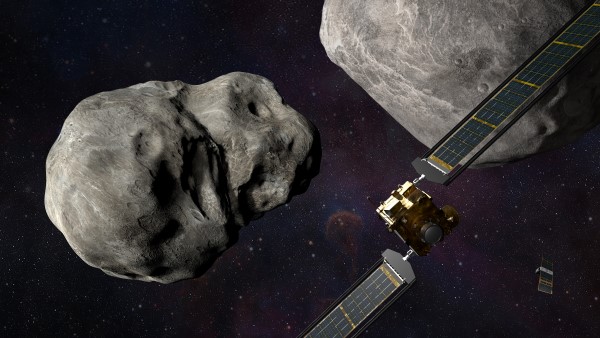
NASA has launched a mission to test whether it is possible to deflect an asteroid using “kinetic impact”. The Double Asteroid Redirection Test (DART) craft – the first mission dedicated to demonstrating this method of asteroid deflection – took off at 06:20 UTC today from Vandenberg Space Force Base, California, aboard a SpaceX Falcon 9 rocket. The mission will slam into a binary asteroid to see if the kinetic impact of a spacecraft could one day successfully deflect an asteroid that is on a collision course with Earth.
DART is a critical next step for planetary defence
Cristina Thomas
Asteroids and comets that orbit the Sun like the planets are collectively known as near-Earth objects (NEOs) and are dangerous because they can come within 50 km of Earth’s orbit. In 2005 the US Congress called on NASA to find, track and characterize – by 2020 – at least 90% of the predicted number of NEOs that are 140 m or larger in size. While no known asteroid bigger than 140 m has a significant chance to hit Earth over the next century, fewer than half of the estimated 25,000 NEOs that are 140 m and larger in size have been found to date.
Weighing around 60 kg, DART’s target is a binary, near-Earth asteroid system that consists of a 780 m-diameter asteroid called “Didymos” and a smaller, 160 m body “Dimorphos” that orbits it. The DART payload is made up of a single instrument called DRACO – a high-resolution imager that will take images of Didymos and Dimorphos on approach to measure their size and shape.
The mission also contains the Light Italian CubeSat for Imaging of Asteroids (LICIACube) – a CubeSat that has been contributed by the Italian Space Agency. LICIACube carries two optical cameras and will be deployed from the DART spacecraft 10 days prior to impact.
Measuring impact
DART is expected to carry out the impact on Dimorphos between 26 September and 1 October 2022. It will do so travelling about 6 kilometres per second. Soon after impact, LICIACube will fly past Dimorphos to image the kinetic impact itself, the resultant ejecta plume and possibly the impact crater.
Ground-based observations carried out at several facilities – including the Lowell Discovery Telescope in Arizona, Las Campanas Observatory in Chile, the Las Cumbres Observatory global network, and the Magdalena Ridge Observatory in New Mexico – will also track the impact of DART and the subsequent response by Dimorphos. The asteroid trillionaires
Scientists will then compare the results of DART’s kinetic impact with computer simulations to evaluate the effectiveness of this approach and assess how best to apply it to future planetary defence scenarios. “DART is a critical next step for planetary defence,” says planetary astronomer Cristina Thomas from Northern Arizona University who heads the DART observations working group. “It is, on the surface, a simple test, but we will not completely understand what will happen until we do it.”
In 2024 the European Space Agency’s Hera mission will launch to the asteroid system and, once it arrives two years later, it will perform a close-up “crime-scene” investigation of DART’s impact.



